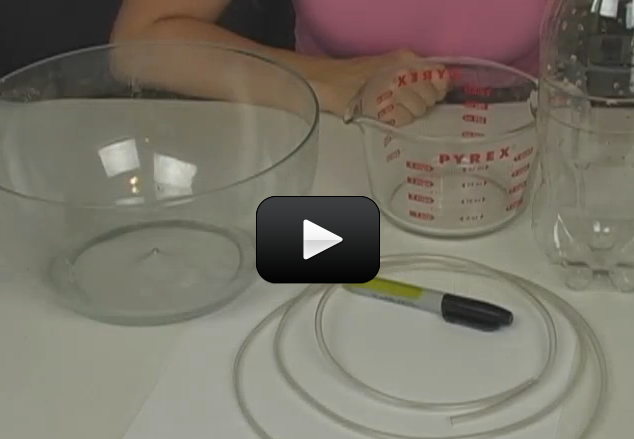Today you will make a calibrated, or marked, container that you will use to measure your lung capacity. You will fill the calibrated container with water, slide a hose into it, take a really deep breath, and blow in the hose. As the air in your lungs enters the container, it will push out the water inside. Just blow as long and as much as you can, then when you flip the bottle over you will be able to read the amount of water you have displaced. If you will subtract the water displaced from the total amount of water in the bottle, the result is your lung capacity.
[am4show have=’p8;p9;p11;p38;p92;p29;p56;p81;p87;’ guest_error=’Guest error message’ user_error=’User error message’ ]
Here’s what you need
-
- 1 2-liter soda bottle
- 1 black marker, permanent
- 1 12” length of rubber hose
- 1 large plastic bowl
- 1 cup measure
Download Student Worksheet & Exercises
Here’s what you do
- Fill the 1 cup measure with water. Pour this into the 2-liter bottle and mark the water level with a line using the black, permanent marker. Also, write 1 cup next to the line. Keep adding water, one cup at a time, marking each new 1 cup increment until you have filled the bottle with water.
- Now flip the newly-filled bottle of water over 1 cup measure until the cup is about 1/3 full. Put one end of the rubber hose in the top of the bottle (which should be now under water).
- Take a really deep breath – as deep as you can – and blow your breath out into the tube. Continue to blow until you can’t push any more air into the bottle. As air goes in the bottle, it pushes an amount of water equal to its volume out and into the bowl.
- Put the lid on the bottle and turn it over before lifting it out of the water. How much water is left in the bottle? Subtract this amount from 8.5 cups. This should be your lung capacity.
- Record your lung capacity in your data records as, “My lung capacity is ____________ cups.” You can convert this number to milliliters by multiplying by 0.24. For example, 19 cups would equal 4.5 liters.
What’s going on?
A person who is 70 years old has breathed about 600,000,000 times in their life. But they have also breathed a lot of air – about 13,000,000 cubic feet. This is enough air to fill 52 blimps!
A man’s lungs have a greater capacity than a woman’s – it’s about 6 liters for a man and 4.2 liters for a woman. And since a grown-up has a greater lung capacity than a kid, it makes sense that a 10-year old might breathe 20 times per minute when a grown-up might breathe only 12 times in a minute.
Exercises
- Which body system are your lungs a part of?
- What are some other parts in this system?
- Explain this system’s major function.
[/am4show]


A “siphon” (A cipher is a secret code, like when you send a secret message!) refers to how water flows uphill against gravity without having a pump involved. If you look carefully at the entrance and exit points for the water in the tube, the exit needs to be lower than the entrance for this to work. The idea that “water seeks its own level” means than water will flow until all of it is at the same level potential-energy-wise. The higher water is, the more gravitational potential energy it will have (the “could” energy), and it will accelerate in the direction to reduce the potential energy as soon as it can.
Water has more than one kind of potential energy – it also has energy due to pressure. Higher pressure water has more energy than lower pressure water (think of the water coming out of a firehose vs a garden hose). Water tens to accelerate from high pressure to low, from high potential energy to power, even without gravity involved. If you place water in a vertical column (tube) and look near the top, it will have less potential energy due to pressure than the water near the bottom of the tube due to the weight of the water.
In a siphon, when the tube goes up first from the higher container and then down to a lower container, the water weight in the downward part of the tube decreases the pressure inside the first part of the tube (where the water is rising). Total potential energy is decreasing the whole time, even when the water is rising, because the pressure potential energy drops quickly to make up for the rise in gravitational energy when it travels downward toward the bottom container.
We did this experiment!
After blowing the water out of the bottle, our mom showed us how to cipher water back into the bottle. Instead of blowing it out we made the hose put the water back in.
Question about ciphering: what keeps the water coming out of the hose after the initial suck to get it coming? What is happening in ciphering?